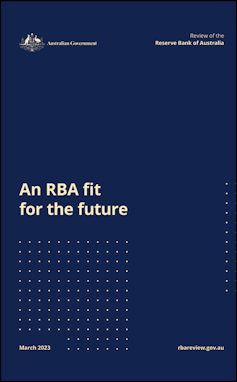Misinformation is circulating about recommendations concerning the Reserve Bank board made by the RBA Review, of which I was a member.
Among the claims are that the new monetary policy board we have proposed would “weaken” incoming governor Michele Bullock’s power over interest rates, and that giving part-time appointees majority control over important decisions would be a “dangerous mistake”.
The claims need to be corrected.
The Review of the Reserve Bank of Australia, conducted between July 2022 and March 2023, made 51 recommendations, which Treasurer Jim Chalmers is now considering.
The review consulted 137 people, including 27 current or past board members, conducted 224 meetings, surveyed 1,100 people, received 117 submissions, and met with 31 community, labour, business and industry groups and 14 former and current politicians.
We recommended that interest rate and other monetary policy decisions by the Reserve Bank be undertaken by an expert board with diverse perspectives and knowledge.
This board would be responsible only for monetary policy decisions and oversight of the bank’s contribution to financial system stability. Governance would be taken care of by a separate corporate governance board.
Our recommendations would not involve handing power to outsiders, as some commentators have claimed. In fact, the changes don’t deviate too much from what is already in the legislation. Here’s why.
Board composition
The Reserve Bank board consists of nine members: the Reserve Bank governor, deputy governor, secretary to the Treasury, and six external members who serve part-time.
Our recommended monetary policy board would have exactly the same composition.
Board responsibilities
Former Reserve Bank governor Ian Macfarlane told the Australian Financial Review the existing board has traditionally acted more like an “advisory” committee and less like a voting board, allowing the governor and bank insiders to retain control of monetary policy.
Yet just-departed governor Philip Lowe said earlier this month that the proposed model is “exactly” the same as the model the Reserve Bank has had for 60 years.
As Lowe put it:
It has never been the case that the governor just comes with a recommendation and just forces it through, the decisions are genuinely taken by nine people together, and we discuss issues from every angle.
Both views were what we heard in our consultations.
Voting is specified by the Reserve Bank Act. It requires that questions arising at board meetings be “decided by a majority of the votes of the members present and voting”.
Our recommendations don’t change that. What they do is better enable the external members to deliver responsible monetary policy, by ensuring they have expertise in things such as macroeconomics, the financial system and labour markets.

We believe this mix of skills will be necessary amid the challenges and uncertainty Australia is likely to face in the future.
We expect more economic disruption from events such as the war in Ukraine, pandemics and climate events. Meanwhile, the rise of factors such as gig work and artificial intelligence will bring changes in the labour market.
We recommended that each external member of the monetary policy board be given direct access to Reserve Bank staff. These staff could provide extra analysis or briefings on the costs, benefits and risks of various possible strategies.
Board appointments
Currently, the treasurer appoints Reserve Bank board members from a “register of eminent candidates of the highest integrity” maintained by the treasury secretary and Reserve Bank governor.
The existing members are doubtless outstanding leaders in their fields. But our review could not identify the criteria used to determine who is added to the register.
We recommended a transparent and strategic appointment process.
Advertisements would be posted asking for expressions of interest, pointing to a set of required skills and experience. A panel comprising the treasury secretary, the governor and a third party would then prepare a shortlist for the treasurer.
We recommended the external members be appointed for a term of five years with a potential one-year extension. End dates would be staggered, ensuring the entire board could not be replaced within a single term of government.
A board of academics?
Despite claims that our review “envisages a committee of academic economists”, the review defined expertise broadly. It said that although the change would “very likely mean more academic expertise” on the board, other experts were likely to include business leaders and professional economists.

Governor outnumbered?
Macfarlane expressed concern that our recommendations would leave the governor “outnumbered” by six part-timers, meaning she would have to defend decisions she disagreed with.
Notwithstanding the fact the board’s composition wouldn’t change from its current makeup, we don’t have to worry about the governor.
I am confident Michele Bullock has what it takes to navigate a tough board and the associated public commentary, as does any strong leader.
Australians need to be sure the very best decisions are being made. Our future depends on it.
Renee McKibbin, Professor of Economics, Crawford School of Public Policy, Australian National University
This article is republished from The Conversation under a Creative Commons license. Read the original article.


